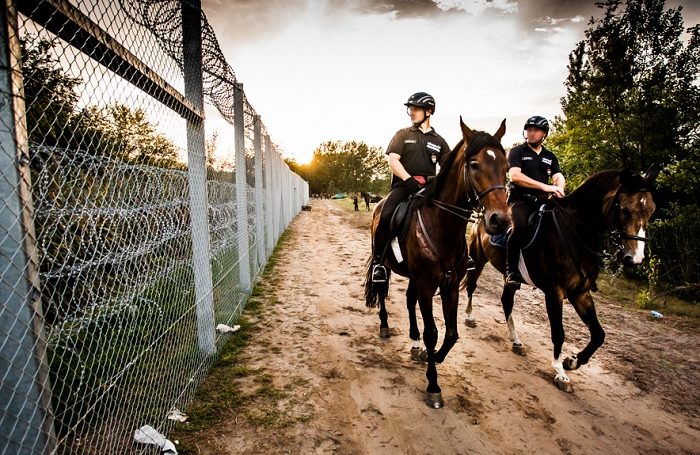
In the summer of 1989, the Minister of Foreign Affairs Gyula Horn of Hungary’s ruling Socialist Party and his Austrian counterpart symbolically cut through the barbed wire on the Hungarian-Austrian border; the ‘Iron Curtain’ was rent. Today, a barbed wire fence on Hungary’s borders with Serbia and Croatia is keeping out refugees (called illegal migrants in government speech) from Hungary.
The country that was the first to open the border between the Soviet bloc and Western Europe in 1989, allowing East Germans to go through Hungary as refugees to the West, is now under a government that claims to be the shield and bastion of Christian Europe.
This is a throwback to the rhetoric of the 1920s and 1930s, when in the wake of the Treaty of Trianon, the Hungarian government fostered the imagery of the country as innocent victim, an ungrateful West having ‘mutilated’ the country that had defended it for centuries against ‘hordes from the east’, allowing ‘peaceful western development’.
While the rhetoric is traditional and familiar to Hungarians, thus easily revived, historical precedent shows that even at best it only worked within the country, rather than outside it. In the interwar period, such propaganda was ineffective towards western politicians, but it was noxiously pervasive inside the country. The idea became part of national identity: it permeated everyday life and generations were brought up learning it in school.
The ‘historical’ narrative at the core of this nationalist identity, unsurprisingly, is ahistorical. The usual enemies against whom Hungary supposedly served as the bastion of Europe were the Mongols and the Ottomans. The Mongols, in fact, withdrew after a successful but short invasion of Hungary and Poland in the middle of the thirteenth century. Relations to the Ottomans were much more complex. On the one hand, resistance to the Ottomans was by no means a purely Hungarian endeavour. On the other hand, Hungarians were as involved in opening Europe to the Ottomans as they were in fighting them. In the succession dispute between John Szapolyai and Archduke Ferdinand I of Austria, the former called in the Ottomans in the sixteenth century. Subsequently, after Habsburg rule was established in Hungary, many rebels sided with the Ottomans against the Habsburgs. Thus it was that the Hungarian rebel Count Imre Thököly fought at the siege of Vienna (1683) – on the Ottoman side.
The rhetoric of having defended Europe against the Ottomans, amalgamated with the claim of now defending Christian values against Muslims, is harnessed to the government’s nationalist anti-Brussels bluster. The latter was clearly expressed in the populist rhetoric of ‘defending’ Hungary against ‘illegal migrants’ and Brussels that wishes to impose them on the country. The vast majority of refugees wanted to travel through Hungary rather than to stay there, and the proposed resettlement quota for Hungary in September 2015 was 1294 refugees. The government, however, claimed this would have tragic consequences for Christian Hungary and called a referendum on whether ‘the EU without Parliamentary approval should be able to prescribe the obligatory immigration of non-Hungarian citizens’. The government’s campaign, including posters on billboards, cost €31.4 million.
‘Did you know? Last year one and a half million illegal immigrants arrived in Europe. Referendum 2 October 2016’, was the caption on an advertisement commissioned by the government’s campaign in the run-up to the referendum. ‘Did you know? The attack in Paris was committed by immigrants’, stated another poster.
Yet the anti-immigrant rhetoric and ‘shield of Europe’ posturing no longer worked even on the majority of Hungarian voters. Opposition parties caricatured the ‘Did you know’ posters, and urged people not to vote. The referendum on 2 October 2016 was invalid due to insufficient turnout, but this did not stop the government from claiming that they represented the will of the people (3,362,224 who voted ‘no’) in proposing an amendment to the constitution to resist settling ‘migrants’. The amendment, however, failed to garner enough support in Parliament and did not pass.
The government’s anti-‘migrant’, anti-EU posturing continues. Patrolling the fence is accompanied by increasing brutality against refugees on the border. Yet the real meaning of the construction of the fence is not to defend Europe or even Hungary. It is another instance of populist strategies in support of the creation and maintenance of the ‘mafia state,’ where, keeping a firm grip on power, state structures are used to further private wealth.
Despite the outcome of the referendum, such strategies are not useless: the government’s proposition garnered the support of over three million people (about 40% of those eligible to vote).
The barbed wire fence on the Hungarian border signals the demolition of democratic values rather than the protection of Europe. Since Auschwitz, the barbed wire fence is a powerful symbol, not of defence, but of oppression. Hungary, the barbed wire fence of Europe, is a reminder that democracy is not a natural state of affairs; a reminder that xenophobia is a powerful tool to mobilize popular support, and the rising tide of autocracy can harness it effectively.
Further Reading on E-International Relations
- Opinion – The Trouble with Hungary
- Balancing in Central Europe: Great Britain and Hungary in the 1920s
- Opinion – A New Pact on Migration and Asylum in Europe
- From Narratives to Perceptions in the Securitisation of the Migratory Crisis in Europe
- Solidarity Beyond the State in Europe’s Common European Asylum System
- Hungary’s Place in German South-East European Policy, 1919–1944